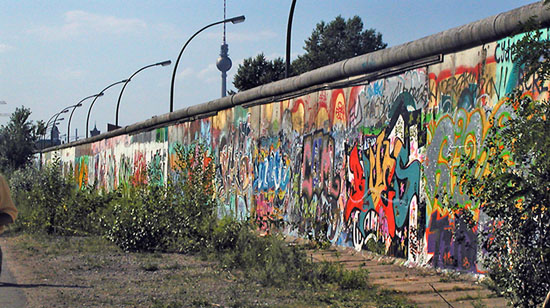Unit 13: Gorbachev

Mikhail Gorbachev did bring about the tearing down of the Berlin Wall, a portion of which is pictured here, in 1989.
- Read the textbook chapter 42.
- Check the remarks by Professor Blois and Professor Evans on Gorbachev.
- Study the Questions to Consider and the Key Terms for the Unit.
- Post (or respond) your thoughts/ideas about this Unit's reading and assignment in the Blackboard online discussion forum. Do not post your assignment there.
- Submit the Gorbachev paragraph.
- Read Gorbachev on 1989 by Katrina vanden Heuvel and Stephen Cohen from The Nation (16 November 2009).
- Profile of Mikhail Gorbachev
- Gorbachev reflects on course of modern Russia
- Gorbachev (biography)
- Mikhail Gorbachev turns 80
- Gorbachev, Glasnost, Perestroika, Arms Agreement
- Gorbachev Resigns: December 25, 1991
- Nov. 10, 1989: Celebration at the Berlin Wall
- Mikhail Gorbachev On 20th Anniversary Of Fall Of Berlin Wall
- Gorbachev: The Great Dissident, Programme One, Part 1
- For extra credit please suggest to your instructor a relevant video for this unit of the course. Send the title of the video, the url and a brief explanation of why you find the video interesting and applicable to the material that is being studied in this unit.
- For 50 points maximum extra credit, watch Malenkaia Vera (Little Vera) and, in a one-page paper, assess the accuracy of the film's portrayal of Soviet society in the 1980s.
- For 50 points maximum extra credit, watch Moscow on the Hudson and, in a one-page paper, assess the accuracy of the film's portrayal of the Russian experience.
- For 50 points maximum extra credit, read Andrei Amalrik, Will the Soviet Union Survive until 1984? (1971) and write a one-page paper in which you assess the accuracy of Amalrik's ideas.
- For 50 points maximum extra credit, read Mikhail Gorbachev, Perestroika: New Thinking for Our Country and the World (1987) and write a one-page paper explaining the main points of Gorbachev's policy of perestroika.
- For 50 points maximum extra credit, read Lech Walesa, The Struggle and the Triumph: An Autobiography (1992), not a Russian but an important political figure, and write a one-page paper explaining the success of the Solidarity Movement.
- For 50 points maximum extra credit, read Alla Yaroshinskaya, Chernobyl: The Forbidden Truth (1995) and write a one-page paper explaining what went wrong at Chernobyl.
- For 50 points maximum extra credit, read Anatolii Rybakov, Children of the Arbat (1987) and write a one-page paper about the author's portrayal of the legacy of Stalinism.